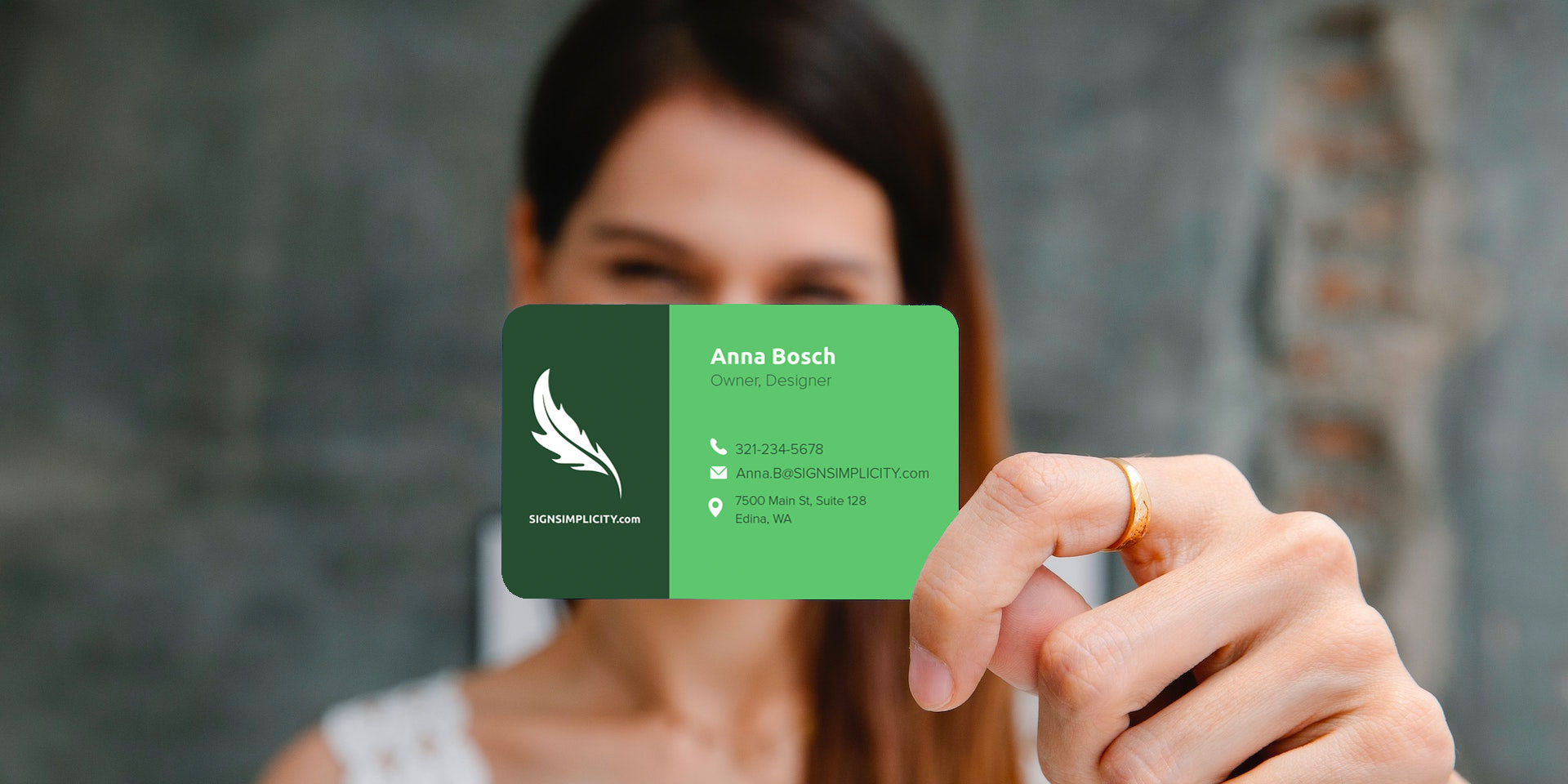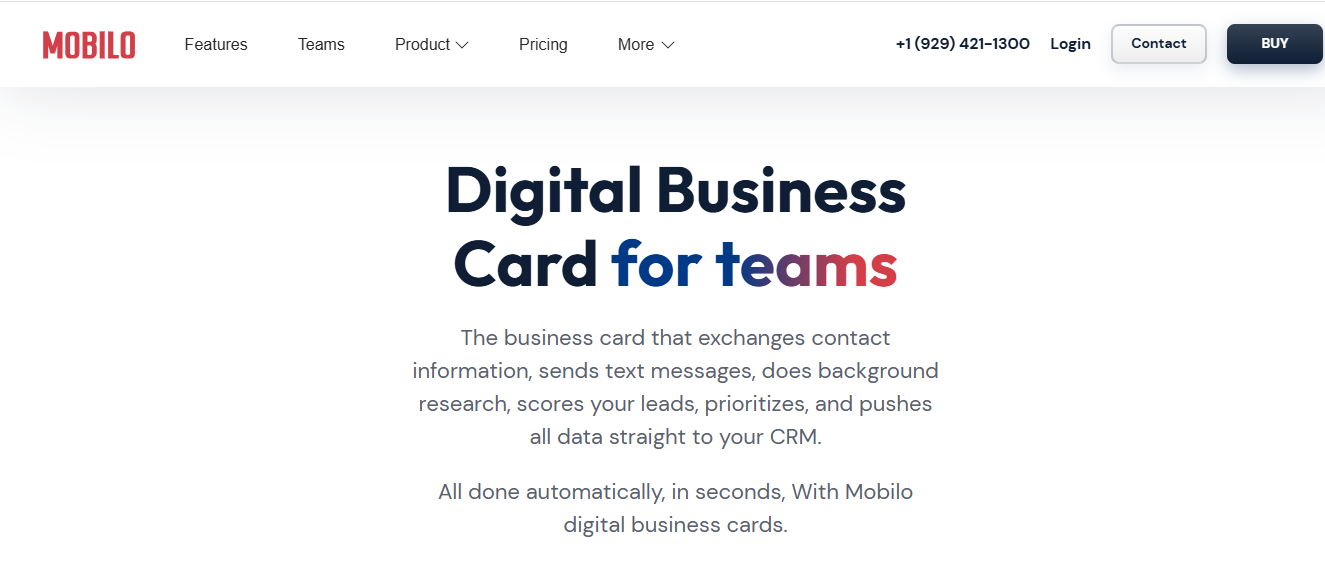.svg)

At a crowded conference, your paper card slides to the bottom of a sleeve, and the moment is gone. NFC technology changes that by allowing you to tap to share contact information, links, and media in one instant action. This article explains how to make your business card stand out, capturing attention, leaving a stronger impression, and building connections that lead to career growth.
Mobilo's Digital Business Card helps you turn a brief exchange into a lasting connection by allowing you to tap to share contact details, customize your brand, and track follow-ups with ease.

A professional business card must clearly convey who you are, how to reach you, and what will happen when someone follows up, while maintaining a balance with your brand voice. Get those three right, and the card becomes a reliable bridge between a handshake and a real conversation.
Prioritize the contact method you expect people to use first. If you want fast follow-ups, place a direct phone or primary email where thumbs naturally land, and keep social handles limited to the platforms you actively monitor.
Avoid a scattershot approach; this pattern appears consistently at conferences and client meetings, where cards stuffed with every possible channel leave recipients unsure which route to take, and next steps get lost.
Present name, role, and company with a clear visual hierarchy so the eye reads them in order. Use weight and size to separate identity from role, and give the logo breathing room so it reads as a stamp of authority, not visual noise. The failure mode I see most often is trying to be clever with placement, which breaks scanning speed and erodes trust seconds into first impressions.
Design is storytelling with constraints. Choose a palette and typography that echo your brand, but let contrast and white space do the heavy lifting for readability. When images, gradients, or heavy patterns fight with text, the card becomes a decorative object rather than a tool; that tradeoff looks expensive and performs poorly.
Physical feel signals value. According to Tapni Blog, 72% of people judge a company or person based on the quality of their business card. Published in 2023, material and finish influence first impressions more than most people assume.
When a card appears cheap, the consequences extend beyond embarrassment, as shown by Wave Connect, which found that 39% of people would choose not to do business with someone who had a 'cheap-looking' business card, published in 2025. Select a weight, coating, or subtle texture that feels deliberate, and consider sustainable options if your brand emphasizes sustainability and responsibility.
If you add a QR or NFC chip, treat it like an access point, not a crutch. Label it clearly and design the card so that the identifier does not compete with the primary contact information. When teams use NFC or NameDrop in conjunction with a concise printed call-to-action, they preserve the tactile signal while capturing instant data on the other side.
Tiny type, low contrast, long URLs, and ornate scripts are visually unappealing and break the eye's attention at a glance. Leave margins, test the card at handshake distance, and ask one non-designer colleague to read it from a distance of four feet. This simple check exposes standard failure modes before you print a hundred cards.
Use one distinct feature, not all of them. A small headshot is particularly helpful in service professions where face recognition is crucial. A brief tagline clarifies your promise.
A single QR code placed with purpose invites action, and an NFC logo can signal modernity without being overly conspicuous. If a recipient cannot understand your next step in under five seconds, remove something.

Make the card memorable by choosing one bold sensory decision, then execute it with discipline so the card reads premium, communicates a single next step, and captures the contact instantly.
Choose heavier weights and unexpected substrates so that the first tactile impression aligns with the message you want to convey. Try 600–900 gsm cotton or a 1.2 mm bamboo veneer for a durable feel; pair that with rounded edges so the card slides into a wallet without catching.
For a construction or product brand, match the material to the craft, for example, by embedding a thin, recycled composite used on-site into the card, so the touchpoint becomes demonstrable proof of expertise. Print choices also matter, so request press proofs and a swatch book before placing your order.
Pick one accent color that reflects your brand’s personality and use it intentionally, such as edge painting, a layered sandwich core, or a full-bleed reverse on the inside of a folded card.
Sandwich two different colored cores to create a subtle stripe visible on the card’s edge, or print a bold color block on the back to create instant separation when the card sits in a stack. Test the color under both indoor and outdoor lighting to avoid surprises at events.
Introduce tactile contrast with spot varnish, blind deboss, or micro-engraving to guide the thumb and eyes. Use blind deboss for logos so people discover the mark by touch; use micro-engraving to add tiny, brand-specific patterns that reward close inspection. When applying texture, keep the type minimal and increase tracking for legibility, so tactile elements enhance rather than compete.
Trim corners, use a square, or add a rounded tab that mimics the product silhouette, but always confirm the fit with standard storage options, such as wallet pockets and cardholders. If you opt for an oversized piece, fold it to a wallet-safe size or create a perforated panel that detaches into a standard card. Maintain one side that is strictly contact information so novelty does not obstruct readability.
Reserve the reverse for functional value, not decoration. Use the back for a concise CTA, a short URL, or a scannable card-specific code that directs users to relevant content. Consider a dual-layer approach, such as a visual brand on one side and machine-readable action on the other, so recipients receive both brand memory and actionable follow-up.
Use NFC or QR as a persistent, trackable continuation of the physical exchange, so a tossed card can still become a pipeline. According to Digital Printing UK, 88% of business cards are discarded within a week, so ensure every physical handoff includes a low-friction method to capture the lead before disposal.
Design the landing experience for immediate value, not a homepage; for example, a one-click calendar invite, a short intro video, or a downloadable one-pager.
Place the NFC chip away from heavy foil, metal finishes, or dense inks, and test tapping with multiple phone models before final production. Specify a chip tuned for universal compatibility and short-range activation to prevent accidental triggering in a pocket. Map the tap result to a mobile-optimized, single-purpose page that records the interaction and automatically tags the lead source.
Prioritize the information hierarchy visually and mechanically, such as listing name and title first, followed by a single CTA, and then contact microcopy. Add a tiny line of microcopy explaining the tap action, for example, Tap to save contact and schedule a 10-minute intro.
Use progressive disclosure on the landing page so that the first tap captures a name and email, and the second step surfaces optional context, such as company size or interests.
Write short, human-friendly microcopy that clarifies action and reduces friction, for example, 'Thanks, I’ll follow up within 24 hours,' or 'Join our product waitlist.' Include a subtle, unexpected element, such as a minigame or a one-sentence case study, on the landing page to make the interaction memorable without adding cognitive load.
Run a quick field test before ordering 500 or 5,000. Bring prototypes to three different live settings, hand them out to 30 contacts, and track both tap rates and retention after one week. Use that small experiment to identify production issues, ergonomic concerns, and wording that confuses people, then iterate before committing to a full print and integration run.
Most teams handle networking with printed cards and manual follow-ups because it is familiar and straightforward. This approach often breaks down as the scale increases, leading to lost context, dropped contacts, and slow follow-up. As event volume or team size grows, those small frictions compound into missed pipeline and inconsistent reporting.
Platforms like Mobilo provide an alternative path, mapping taps and scans directly into CRM workflows, compressing capture time to seconds and surfacing lead quality so that teams can follow up faster and with context.

You can avoid nearly every common business card pitfall with deliberate checks and a small playbook you follow before every order. Below are the nine frequent mistakes I see, why each one actually damages follow-up, and practical fixes that go beyond the usual advice.
Few things make you look less professional than a spelling error or a phone number that is no longer valid, and it often renders the card useless to the recipient.
Read aloud, then proof one final time in print-size type. When we tested prototypes at three trade shows over three months, a pattern emerged. Corrected contact lines recovered nearly all potential follow-ups that earlier drafts had lost.
Use an approval checklist that requires two sign-offs and a final printed proof before mass printing. If your details change frequently, consider ordering smaller runs or using a dynamic digital endpoint via NFC or a short URL, so the physical card always points to the current contact data.
Jamming in every channel buries the single action you want a new contact to take.
Prioritize one clear call to action and set aside everything else. Replace extra links with a single, short landing URL or a programmable NFC tap that reveals a complete profile. For high-volume teams, create role-specific landing pages so the same card routes sales leads to the right specialist without changing the printed layout.
Design choices that look elegant on a screen can fail in poor lighting or at a pocket size, and people will skip reading rather than strain their eyes.
Select typefaces specifically designed for print and establish baseline sizes that remain legible in low-light conditions. Then, test them with photocopies and a phone camera.
If your brand uses a decorative headline font, reserve it for the name only and pair it with a sturdy sans-serif font for contact information. Run a quick legibility audit by photographing the card from arm’s length and confirming every line is legible without zoom.
A flimsy card signals a lack of attention to detail; recipients handle dozens of cards, and tactile cues play a significant role in shaping trust.
Specify weight and finish in your order, request a swatch, and insist on a press proof. Consider durability choices that match usage, for example, a water-resistant coating for outdoor events. If sustainability matters, ask for FSC-certified stock or a recycled option and include that fact subtly on the back so the benefit becomes an additional credibility signal.
A card without a clear next step is a filing slip, not a conversion tool.
Make the CTA obvious, single-minded, and machine-actionable. Place a one-line command, such as 'Save my contact,' 'Book 10 minutes,' or 'View a case study,' and pair it with an NFC tap or short URL that performs that action immediately. Trackable taps enable teams to see which CTAs are effective at events and iterate on them; use that data to refine messaging between shows.
A free-domain address can undercut authority at a glance.
Use a domain-based email where possible, and standardize addresses across the team for consistent formatting. If you must use a generic provider temporarily, use firstname. Update the last name format and move people to domain-based mail as part of onboarding, so business cards and email signatures are consistent.
Cards without recognizable brand cues blend into a stack.
Lock in a primary logo placement and a single accent color for all team cards so recognition compounds when cards accumulate. For teams, create a small brand kit for card vendors that includes color swatches, logo files, and a one-line descriptor, ensuring consistent production across batches and suppliers.
A purely paper card expects the recipient to type or transcribe, which reduces conversion and introduces errors.
Include at least one digital hook that aligns with how people interact on a phone, and test it with real users before finalizing. If you want analytics, route the hook through a trackable landing page that captures the source, event, and cardholder information. That provides you with measurable follow-up and enables you to automate next steps in your CRM.
Novel shapes can be memorable, but when a card does not fit a wallet or cardholder, recipients are far more likely to discard it later.
Stick to a wallet-friendly profile while using subtle sensory cues for distinctiveness, such as edge color or a tactile logo. If you must experiment with size or shape, create a removable insert that detaches into a standard card, so the novelty does not cost retention.

We know that handing out paper cards feels polite and straightforward, and that familiarity is why teams continue to do it even when follow-up slips away. If you want to change that outcome, consider Mobilo. Book a demo and get your first 25 Cards Free, with extras available for just $3, so you can test savvy, CRM-ready networking without overcommitting.